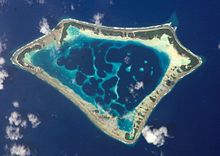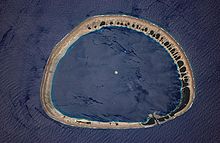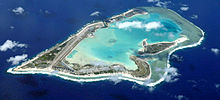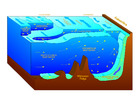- Atoll
-
An atoll (
 /ˈætɒl/ or /æˈtɒl/)[1] is a coral island (or islands) that encircles a lagoon partially or completely.
/ˈætɒl/ or /æˈtɒl/)[1] is a coral island (or islands) that encircles a lagoon partially or completely.Contents
Usage
The word atoll comes from the Dhivehi (an Indo-Aryan language spoken on the Maldive Islands) word atholhu (Dhivehi: އަތޮޅު, [ˈət̪ɔɭu])OED. Its first recorded use in English was in 1625 as atollon - Charles Darwin recognized its indigenous origin and coined, in his The Structure and Distribution of Coral Reefs, the definition of atolls as "..circular groups of coral islets [...] and [the word] is synonymous with 'lagoon-island'." (1842, p. 2). More modern definitions of atoll are those of McNeil (1954, p. 396) as "..an annular reef enclosing a lagoon in which there are no promontories other than reefs and islets composed of reef detritus" and Fairbridge (1950, p. 341) "...in an exclusively morphological sense, [as] ...a ring-shaped ribbon reef enclosing a lagoon."
 Satellite Image of some of the atolls of the Maldives by NASA. A total of 1322 islands arranged into 26 atolls make up the country.
Satellite Image of some of the atolls of the Maldives by NASA. A total of 1322 islands arranged into 26 atolls make up the country.
Distribution and size
The distribution of atolls around the globe is instructive: most of the world's atolls are in the Pacific Ocean (with concentrations in the Tuamotu Islands, Caroline Islands, Marshall Islands, Coral Sea Islands, and the island groups of Kiribati, Tuvalu and Tokelau) and Indian Ocean (the Atolls of the Maldives, the Laccadive Islands, the Chagos Archipelago and the Outer Islands of the Seychelles). The Atlantic Ocean has no large groups of atolls, other than eight atolls east of Nicaragua that belong to the Colombian department of San Andres and Providencia in the Caribbean Sea.
Reef-building corals will thrive only in warm tropical and subtropical waters of oceans and seas, and therefore atolls are only found in the tropics and subtropics. The northernmost atoll of the world is Kure Atoll at 28°24' N, along with other atolls of the Northwestern Hawaiian Islands. The southernmost atolls of the world are Elizabeth Reef at 29°58' S, and nearby Middleton Reef at 29°29' S, in the Tasman Sea, both of which are part of the Coral Sea Islands Territory. The next southerly atoll is Ducie Island in the Pitcairn Islands Group, at 24°40' S. Bermuda is sometimes claimed as the "northernmost atoll" at a latitude of 32°24' N. At this latitude coral reefs would not develop without the warming waters of the Gulf Stream. However, Bermuda is what is termed a pseudo-atoll because its general form, while resembling that of an atoll, has a very different mode of formation. While there is no atoll directly on the Equator, the closest atoll to the Equator is Aranuka of Kiribati, with its southern tip just 12 km North of the Equator.
The largest atolls by total area (lagoon plus reef and dry land)[2] are listed below:
- Saya de Malha Bank, Western Indian Ocean (35000 km²) (without separate North Bank), submerged, least depth 7 m,
- Lansdowne Bank, west of New Caledonia (21000 km²), submerged, least depth 3.7 m [3]
- Great Chagos Bank (12642 km², land area only 4.5 km²)
- Reed Bank, Spratly Islands (8866 km²), submerged, least depth 9 m
- Macclesfield Bank, South China Sea (6448 km²), submerged, least depth 9.2 m
- North Bank (Ritchie Bank, north of Saya de Malha Bank) (5800 km²), submerged, least depth <10 m
- Rosalind Bank, Caribbean Sea (4500 km²), submerged, least depth 7.3 m
- Boduthiladhunmathi (Thiladhunmathi-Miladhunmadulu) Atoll, Maldives, (two names, but a single atoll structure) (3850 km², land area 51 km²)
- Chesterfield Islands, New Caledonia (3500 km², land area <10 km²)
- Huvadhu Atoll, Maldives (3152 km², land area 38.5 km²)
- Truk Lagoon, Chuuk (3130 km²)[4]
- Sabalana Islands, Indonesia (2694 km²)
- Nukuoro atoll, Federated States of Micronesia, lagoon, is 40 km², land area of 1.7 km², divided among more than 40 islets that lie on the northern, eastern and southern sides of the lagoon
- Lihou Reef, Coral Sea (2529 km², land area 1 km²)
- Bassas de Pedro (2474.33 km²), submerged, least depth 16.4 m
- Ardasier Bank, Spratly Islands (2347 km²), cay on the south side?
- Kwajalein, Marshall Islands (2304 km², land area 16.4 km²)
- Diamond Islets Bank, Coral Sea (2282 km², land area <1 km²)
- Namonuito Atoll, Chuuk (2267 km², land area 4.4 km²)
- Ari Atoll, Maldives (2252 km², land area 69 km²)
- Maro Reef, Northwestern Hawaiian Islands, 1934 km²
- Rangiroa, Tuamotu Islands (1762 km², land area 79 km²)
- Kolhumadulhu Atoll, Maldives (1617 km², land area 79 km²)
- North Malé Atoll, Maldives (1565 km², land area 69 km²)
- Ontong Java, Solomon Islands (1500 km², land area 12 km²)
In most cases, the land area of an atoll is very small in comparison to the total area. According to,[5] Lifou (land area 1146 km²) is the largest raised coral atoll of the world, followed by Rennell Island (660 km²). More sources however list as the largest atoll in the world in terms of land area Kiritimati, which is also a raised coral atoll (321.37 km² land area; according to other sources even 575 km²), 160 km² main lagoon, 168 km² other lagoons (according to other sources 319 km² total lagoon size). The remains of an ancient atoll as a hill in a limestone area is called a reef knoll. The second largest atoll by dry land area is Aldabra with 155 km². The largest atoll in terms of island numbers is Huvadhu Atoll in the south of the Maldives with 255 islands.
Formation
See also: Formation of coral reefsIn 1842 Darwin explained the creation of coral atolls in the southern Pacific Ocean based upon observations made during a five-year voyage aboard the HMS Beagle from 1831 to 1836. Accepted as basically correct, his explanation involved considering that several tropical island types—from high volcanic island, through barrier reef island, to atoll—represented a sequence of gradual subsidence of what started as an oceanic volcano. He reasoned that a fringing coral reef surrounding a volcanic island in the tropical sea will grow upwards as the island subsides (sinks), becoming an "almost atoll", or barrier reef island, as typified by an island such as Aitutaki in the Cook Islands, Bora Bora and others in the Society Islands. The fringing reef becomes a barrier reef for the reason that the outer part of the reef maintains itself near sea level through biotic growth, while the inner part of the reef falls behind, becoming a lagoon because conditions are less favorable for the coral and calcareous algae responsible for most reef growth. In time, subsidence carries the old volcano below the ocean surface and the barrier reef remains. At this point, the island has become an atoll.
Atolls are the product of the growth of tropical marine organisms, and so these islands are only found in warm tropical waters. Volcanic islands located beyond the warm water temperature requirements of reef building, or hermatypic, organisms become seamounts as they subside and are eroded away at the surface. An island that is located where the ocean water temperatures are just sufficiently warm for upward reef growth to keep pace with the rate of subsidence is said to be at the Darwin Point. Islands in colder, more polar regions evolve towards seamounts or guyots; warmer, more equatorial islands evolve towards atolls, for example Kure Atoll.
-
As the island and ocean floor subside, coral growth builds a fringing reef, often including a shallow lagoon between the land and the main reef
-
As the subsidence continues the fringing reef becomes a larger barrier reef farther from the shore with a bigger and deeper lagoon inside
Reginald Aldworth Daly offered a somewhat different explanation for atoll formation: islands worn away by erosion, by ocean waves and streams, during the last glacial stand of the sea of some 900 feet (270 m) below present sea level developed as coral islands (atolls), or barrier reefs on a platform surrounding a volcanic island not completely worn away, as sea level gradually rose from melting of the glaciers. Discovery of the great depth of the volcanic remnant beneath many atolls such as at Midway Atoll favors the Darwin explanation, although there can be little doubt that fluctuating sea level has had considerable influence on atolls and other reefs.
Coral atolls are also an important place where dolomitization of calcite occurs. At certain depths water is undersaturated in calcium carbonate but saturated in dolomite. Convection created by tides and sea currents enhance this change. Hydrothermal currents created by volcanoes under the atoll may also play an important role.
United States national monuments
Aerial overview of the Wake Island atoll, part of the Pacific Remote Islands Marine National Monument.
As of January 6, 2009 U.S. President Bush announced that several remote Pacific islands under U.S. jurisdiction are now national monuments, protecting coral reefs.[6][7]
See also
- Continent
- Coral Reef
- Guyot
- Islomania
- Low island
- Peninsula
- Pseudo-atoll
References
- ^ pronunciation in old video on youtube, Bikini Atoll video
- ^ ftp://rock.geosociety.org/pub/reposit/2001/2001075.pdf Atoll Area, Depth and Rainfall] (2001) spreadsheet from The Geologicl Society of America. Retrieved d.d. October 1, 2009.
- ^ Lansdowne Bank "21 000" - Meine Bibliothek - Google Bücher
- ^ http://conserveonline.org/workspaces/pacific.island.countries.publications/fsm/fsmblueprint
- ^ Misinformation about Islands
- ^ Presidential Proclamation 8336
- ^ Weekly Compilation of Presidential Documents: Monday, January 12, 2009 Volume 45—Number 1, Page 14
Further reading
- Darwin, C. 1842. The structure and distribution of coral reefs. London.
- Dobbs, David. 2005. Reef Madness : Charles Darwin, Alexander Agassiz, and the Meaning of Coral. Pantheon. ISBN 0-375-42161-0
- Fairbridge, R. W. 1950. Recent and Pleistocene coral reefs of Australia. J. Geol., 58(4): 330–401.
- McNeil, F. S. 1954. Organic reefs and banks and associated detrital sediments. Amer. J. Sci., 252(7): 385–401.
External links
- Formation of Bermuda reefs
- Darwin's Volcano - a short video discussing Darwin and Agassiz' coral reef formation debate
Corals and coral reefs Stony corals 
Soft corals - Alcyonacea
- Black coral
- Bamboo coral
- Organ pipe coral
- Sea fans
- Sea pens
Coral reefs - Atoll reef
- Cay
- Fringing reef
- Microatoll
- Coral reef fish
- Census of Coral Reefs
- The Structure and Distribution of Coral Reefs
Coral regions Coral diseases - Coral bleaching
- Black band disease
- Skeletal eroding band
- White band disease
- White pox disease
Protection - Coral reef protection
- Project AWARE
- Reef Check
- Reef Ball
- Coral Reef Alliance
- International Society for Reef Studies
Other - Artificial reef
- Coral aquaculture
- Coral dermatitis
- Coral (precious)
- Coral rag
- Coral sand
- Coralline algae
- Human impact
- Fire coral
- Rugosa (extinct)
- Tabulate (extinct)
- Zooxanthella
Categories:- Atolls
- Coastal and oceanic landforms
- Islands
Wikimedia Foundation. 2010.







